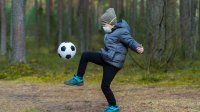How to Keep Physical Education Fun and Safe for Elementary Students
A few inexpensive items and strict rules about Covid-19 protocols can allow schools to give students proper PE whether they’re in hybrid or remote learning.
This fall every teacher asked themselves the same questions: What will our teaching look like? Will it be in-person or remote? And how will our students and colleagues stay safe?
My colleagues and I in the Germantown Friends School (GFS) Physical Education department were asking the same questions. When we learned that we would be phasing back into in-person learning, we began to ponder logistical questions related to keeping students engaged in vigorous physical activity safely.
We centered ourselves on the driving question: What is best for our students? The spring lockdown last year reinforced that our students needed physical education (PE) now more than ever. The benefits of moderate-to-vigorous activity for memory retention and focus are paramount, and the positive interactions of social-emotional learning that occur during PE are critical for learning, particularly during stressful periods. Beyond that, we also knew that for kindergarten through fifth-grade learners, we would need to adapt our spaces, equipment, and pedagogy for students both on-campus and remote.
Adjusting to Support Safety
We relied on guidance from city, state, and national health care experts as well as our medical advisory board, which consists of medical professionals within our school’s current family and alumni. Using a structure outlined with school-wide mitigation protocols, we adjusted our schedule to have all PE classes outdoors with required mask-wearing and physical distancing of at least six feet.
Our largest classes have no more than 18 students. We painted our spaces with markers to indicate six feet and designed five to 10 mask break areas for students to use during higher-intensity levels of class as needed. Each teacher would adjust their lessons to include time for these self-selected mask breaks, along with full-class mask breaks after vigorous activity. Students sit in one direction and were quickly taught that there’s no talking while taking a mask break. These mask breaks soon became a “normal” classroom routine.
Cleaning is another important factor. We’re able to share equipment within a single class but must disinfect in between periods. Our beautiful gyms turned into equipment cleaning and drying stations as we adjusted lesson planning based on our new cleaning protocols. These changes and the time involved were significant, but the adjustments seemed easy compared to the pedagogical changes to make our class include the critical social-emotional learning, skill practice, and high-intensity levels our students were craving.
Maintaining Class Favorites
We knew that familiarity and fun programming would be important during this time of uncertainty, especially for our youngest students, and we wondered how we could reimagine some of our favorite PE activities. After we purchased every pool noodle from the local dollar store, our elementary students’ dream of tag quickly became a reality. Taggers would have pool noodles and tag students with the noodle. Our tag games at every grade level were back in action with minor adjustments to the rules along the way.
Luckily, our skill practice in throwing, catching, and striking needed little adjustment as students could work with partners stationary and move in their own designated areas.
Invasion games were adjusted, so each team only had two taggers/defenders while everyone else was playing offense. Another adaptation was that each student was given a noodle to tag each other. Our third- through fifth-grade curriculum focuses on small-sided games with an emphasis on team strategies. Our teachers brainstormed and adjusted how the games would be played. For example, one to two defenders with a noodle would be allowed only to tag, while three to five offenders would work to move into space and create better passing opportunities. The scoring of the game was also adjusted. A dropped pass was a point for the defender, rather than a traditional interception. The offense could only get the point after three successful passes. If you got tagged by the noodle after possessing the ball for a designated time period (three seconds), it resulted in a point for the defender. This worked tremendously well with our football, ultimate Frisbee, and field hockey units.
PE Is Invaluable During Remote Learning
As we worked with our on-campus students, our remote learners were also engaging in PE. We learned during the spring that we needed to supply limited equipment for at-home use to create equality among our learners. We chose one tennis ball and one jump rope for every K–5 learner. As a department, we felt that having live, synchronous time with our remote students was essential to create connections and inspire fun learning. Although it wasn’t sustainable to have a full 30- to 40-minute class three times per week for our remote learners, we did want to create a plan to “see” and deliver successful remote PE to our students.
First, aligning with the remote teachers, we “super graded” remote classrooms within our department, meaning our PE faculty joined the regular classrooms and teachers. Aligned with the structure of the full Lower School remote schedule, our super-graded teaching included kindergarten and first grade, second and third, and fourth and fifth. Teachers worked within the remote-teacher schedule to have one or two asynchronous lessons and two or three live sessions first thing in the morning for remote learners. PE teachers then had the opportunity to connect with their remote learners while sharing the additional teaching load with a colleague, giving way to more creative and collaborative classes.
As fall fades into winter, we’re wondering what’s sustainable for the colder months. As we adjust our class sizes to limit the number of students inside gyms, we prepare our students to come dressed ready to be outside and move. Just like mask-wearing, we hope our students adjust quickly to colder weather to allow PE to support their social-emotional learning, moderate-to-vigorous exercise, and overall well-being.
